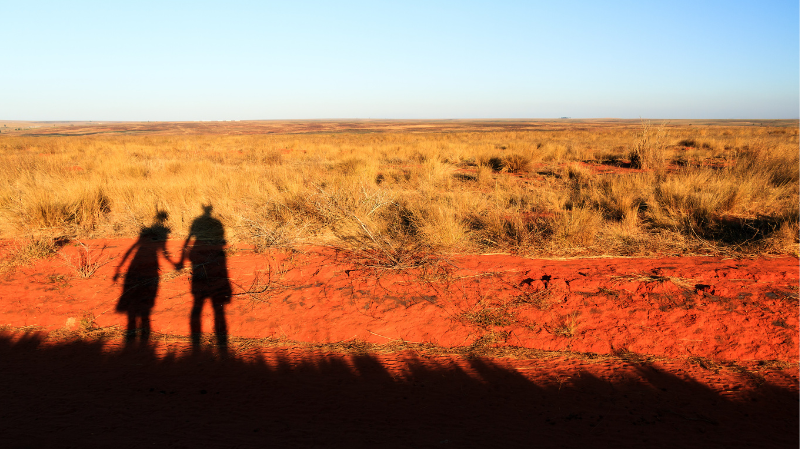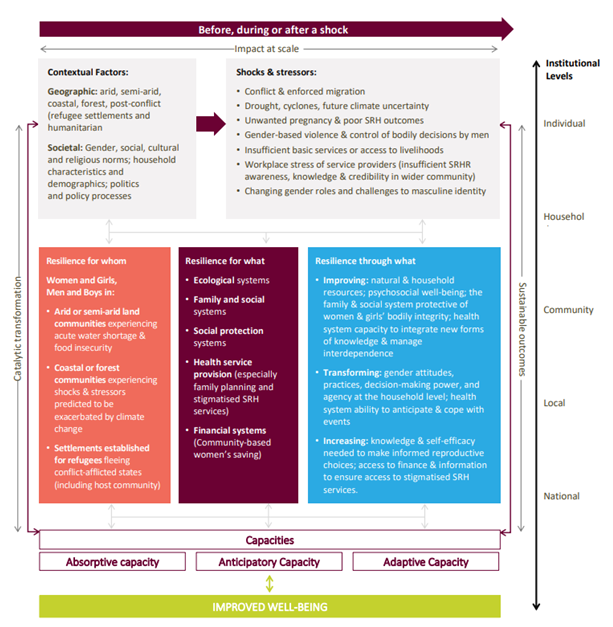The effects of climate change are gendered. The disruption and uncertainty created by climate change hits women and girls hardest because they are disproportionately affected by poverty, subject to gender discrimination and have poorer access to resources, food and sources of income.

Linking climate change and sexual and reproductive health
In order to effectively respond to events like drought, coastal erosion and desertification, woman and girls need support to build their resilience. Ensuring access to sustainable sexual and reproductive health and rights (SRHR) services and supporting the ability to choose to access services can contribute to resilience, and this resilience may contribute to improved SRHR.
From 2020-22, Itad worked with partners of the ASPIRE programme (Advancing SRHR through the promotion of Innovation & Resilience). The programme, funded by UK Government, was developed to test and generate evidence on innovative, sustainable and scalable approaches to address the challenges of improving SRHR in post-conflict and fragile settings, and areas vulnerable to the impacts of climate change.
Our role was to generate evidence, learning and evaluate how planned innovations can build individual and organisational capacity to change SRHR practices in climate change affected and fragile settings. By understanding how programme innovations build resilient actions and behaviours, we endeavoured to deliver lasting change in the communities served, influence policy at a national level and present replicable models for building resilience in other post-shock contexts.
Lessons from Madagascar
As part of this work, we evaluated the ASPIRE programme pilot in Madagascar to capture learning about integrating SRHR with climate change adaptation. Our findings, while specific to the ASPIRE programme are also relevant to others working on SRHR in areas affected by climate change.
We found that programme implementation is most effective when:
- Coordination between implementing partners is based on commitment, strong processes and shared values.
- Implementers and communities coordinate to build buy-in and the co-creation of solutions.
- Innovative thinking is facilitated by a high level of expertise and competence in the implementing team – and is accompanied by a culture of motivation toward a shared goal.
- Programme activities and approaches align with national and local priorities to ensure buy-in from local authorities.
- Implementors are prepared to tackle challenges associated with basic needs around livelihoods, health, and social cohesion as well as regressive gender norms to ensure engagement with climate change action.
Conceptualizing resilience in terms of climate adaptation
During our work on the ASPIRE programme, we also developed a ‘resilience framework’ – a tool that conceptualises building resilience in terms of absorptive, anticipatory and adaptive capacities to cope with stressors and shocks.
The framework situates SRHR within strategies to build resilience. It is intended to assist with planning, development, and evaluation of the ASPIRE programme but has the potential to be transferred to other programmes and contexts.
The framework takes as its unit of analysis; ‘who’ is at risk of the shock or stressor, be it an individual, household, community or even a health system and then breaks down resilience into three interrelated capacities drawing on literature on resilience to natural disasters: ability to absorb, anticipate, and/or adapt.
It represents a resilience approach that can be applied to understand the factors that are creating vulnerability in a particular context as well as the factors that may increase or build resilience.
The use of a resilience framework helps implementors think through the core components of a resilience approach, consider how SRHR interventions relate to these component and begin to integrate pathways to resilience when integrating SRHR into livelihoods programming.
The framework can also be used to support monitoring and evaluation in conjunction with other MEL approaches.
Tools like the resilience framework and the ASPIRE programme remain at the vanguard of tackling the vulnerabilities of women and girls to the effects of the climate emergency and go some way to helping us unpick the realities of resilience for diverse groups in situations of shock and stress due to climate change.
The Aspire Resilience Framework

(Framework adapted from Ihalainen M, Schure J, Sola P. (2020) ‘Where are the women? A review and conceptual framework for addressing gender equity in charcoal value chains in Sub-Saharan Africa’. Energy for Sustainable Development)
Find out more about our action on climate change

